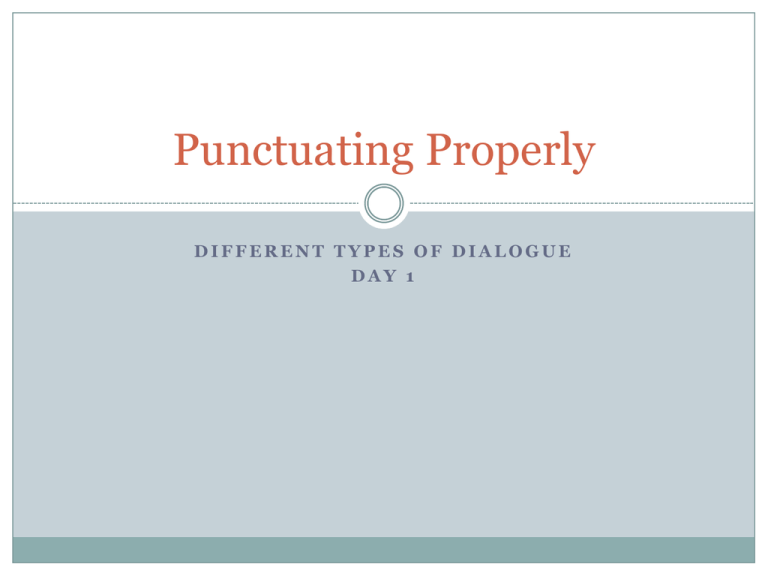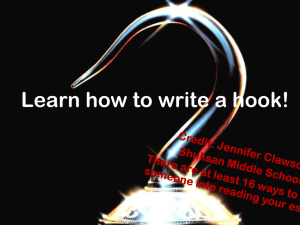Punctuating Properly: Dialogue
advertisement

Punctuating Properly DIFFERENT TYPES OF DIALOGUE DAY 1 Three Different Types of Sentences I’ll take three double cheesburgers said the man in the yellow car Hey, I just met you, and this is crazy sang Carly Rae Jepsen but here’s my number, so call me maybe Shakespeare once said A fool thinks himself to be wise, but a wise man knows himself to be a fool The Identifying Tag I know! Let’s go to the movies said . said Last weekend totally rocked! Once upon a time there lived a big, hairy giant said who loved to throw boulders down hills and into rivers Quoting a Character with Another Character Do you want your character to quote someone else? It’s simple, use single quotation marks within your double quotation marks. “Sarah said Batman Rises was ‘totally awesome,’” said Joey. “Do you think I should trust her? Or should I just skip it?” I want my characters to interrupt each other! Great! You just need to use an ellipses! Using Quotes in Journalism Quotes can be used for a variety of things. When using them for any journalistic source, remember to begin a new paragraph when you change from dialogue to action and back to dialogue. Mark Davis took over as Raiders owner in October following the passing of his father, Al Davis, who was also the franchise's longtime general manager. Davis' son hired Reggie McKenzie, formerly with Green Bay, as his GM shortly after last season, then McKenzie fired coach Hue Jackson and replaced him with former Denver defensive coordinator Dennis Allen. "We respect what Mr. Davis was able to do here, the brand he created with this organization," said Allen, who at 39 is the league's youngest head coach. "We're going to do it our way. That's the only way we know how to do it. Reggie and I have a plan, and we hope to have success doing it that way." One of Oakland's first steps in that plan is to bounce back from a miserable end to 2011. The Raiders were 7-4 and leading the AFC West before dropping four of their final five games to finish 8-8 for the second straight year. The Simple Dialogue Checklist Are all of my ending quotation marks outside of the punctuation? Do all my characters have an identifying tag? Did I remember to use a single quotation mark to quote within my quote? Is my ellipses used correctly? Are all of my commas where they should be? Punctuating Properly DIFFERENT TYPES OF DIALOGUE DAY 2 Directed Dialogue When you think ‘dialogue’ you usually think of Directed Dialogue. “Who’s next? Gil on the car phone. What’s shakin’, Gil?” Dead air. “Speak, Gil.” “Is this…?” “Go on.” “Hello?” “You’re on the JOC.” “Am I on?” “Not for long, Gil, the way we’re going. This is supposed to be entertainment.” Pages 26-23, Writing Dialogue, Tom Chiarella Misdirected Dialogue If you try to write down your lunch conversation as dialogue, it will probably look like Misdirected Dialogue. “I need a soda. Could I have a soda?” 2. “I saw Marnie today.” 1. “Soda, please.” 3. “Where did you see her?” 2. “You know. By the fire station.” 3. “No kidding.” 2. “Her hair has grown.” 3. “I would imagine. How do you know?” 2. “I’m not blind.” 1. Are you eating? Pages 26-23, Writing Dialogue, Tom Chiarella Interpolated Dialogue Interpolated Dialogue interrupts a story to reveal a deep revelation from one particular character. The piece of dialogue typically appears as an outburst and the implicit meaning is left up to the reader’s interpretation. Interpolated Dialogue usually exists to document a short exchange between two characters and uses less than five changes in characters. Interpolated Dialogue Already he was tormented by a strong desire to share his memories with someone. But, in his home it was impossible to talk of love, and he had no one to talk to outside;… And what was there to talk about? He hadn’t loved then, had he? Had there been anything beautiful, poetical, edifying or simply interesting in his relations with Anna Sergeyevna? … One evening, coming out of the physician’s club with an official with whom he had been playing cards, he could not resist saying: “If you only knew what a fascinating woman I became acquainted with at Yalta!” The official got his sledge and was driving away, but turned suddenly and shouted: “Dmitry Dmitrovich!” “What is it?” “You were right this evening: the sturgeon was a bit high.” Those words, so commonplace, for some reason moved Gurov to indignation, and struck him as degrading and unclean. What savage manner, what mugs! What stupid nights, what dull humdrum days! Frenzied gambling, gluttony, drunkenness, continual talk always about the same things! Futile pursuits and conversations always about the same topics take up the better part of one’s time, the better part of one’s strength, and in the end there is left a life clipped and wingless, an absurd mess, and there is no escaping or getting away from it – just as though one were in a prison. Anton Chekov’s “The Lady With the Pet Dog” [Pg 2–29] Modulated Dialogue Modulated Dialogue uses dialogue as a springboard for extensive details. Each exchange by a character is typically marked by several sentences of key memories, flashbacks, commentaries, or other details. The dialogue is usually present in short phrases at the very beginning or end of the paragraphs. Modulated Dialogue “Holy smoke,” I said, to be polite. In truth, I thought that was a pretty good bargain. Suppose he botched a liposuction of misaligned an implant? If I were an insurance company I would not have insured [him] for any amount. He went on to say that some fathers, himself and Ronald Reagan included had a lot at stake…“My heart aches for the President,” he said. “Excuse me,” I said. I wanted seconds before they wheeled the roast beef away. It was already three o’clock, and the steamboat round was carved down the middle like a saddle. The waiter in charge of slicing meat was standing over by the aquarium with two other waiters. I waited politely by the meat, plate in hand, but they were engaged in an argument, and a partially melted seahorse made of ice stood between me and them. They didn’t notice me. Anton Chekov’s “The Lady With the Pet Dog” [Pg 34– 35]








